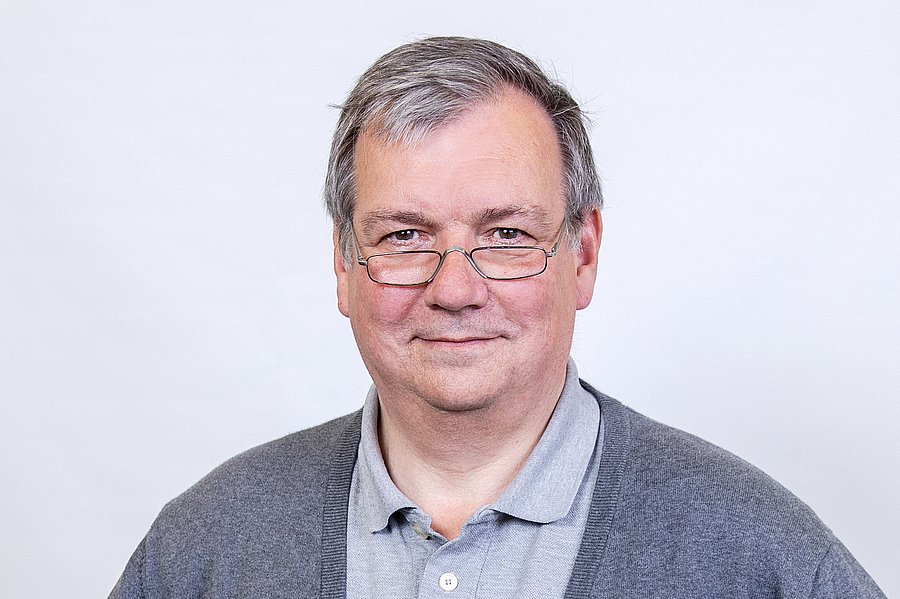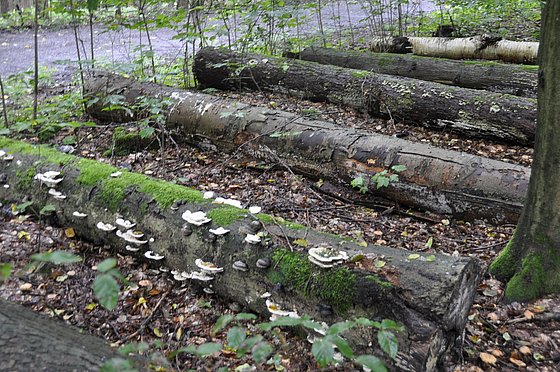
Deadwood project in the Burgholz State Forest
Prof Dr. Willi Kling / Management of Chemical Processes in Industry and Analytical Chemistry
Photo: Sebastian Jarych
"We need trees that can better withstand this climate stress".
Prof. Dr. Hans-Willi Kling and the deadwood project in the Burgholz State Forest
The debate about climate change and all its consequences has gained momentum worldwide, especially with the Fridays for future demonstrations by schoolchildren and students. Our forests are also showing in a drastic way that it is already five to twelve. The increased dieback of native spruce can be observed by walkers in any forest. "If you drive on the Sauerland line toward Frankfurt, you can see our spruce trees from a distance," says Prof. Dr. Hans-Willi Kling, who heads the Chair of Management of Chemical Processes in Industry and Analytical Chemistry at Bergische Universität, "because these are the brown trees that simply died because they simply couldn't cope with several summers of great heat and great drought. They eventually died. The native beech is also already badly damaged in many places and is developing regionally into the second "problem child". Reforestation therefore seems urgently needed, but which trees should be planted instead?

Deadwood in the state forest Burgholz
The deadwood project in the Burgholz State Forest
For a few years now, Kling has been leading the "Deadwood" project in the local Burgholz State Forest in cooperation with the State Forestry and Timber Agency, which is intended to provide insights into how we can save our forest in the long term as well as convert and regenerate it in times of climate change.
"Burgholz has a special significance for us," he reports, "and that is that there is the so-called arboretum in Burgholz. Here, people planted different tree species, native and non-native tree species, quite some time ago." This great outdoor experiment, he said, was established years ago by a prudent forester, and now, in the wake of climate change, it takes on an important significance when it comes to integrating non-native trees or planting them as alternatives. "How do these trees that are not native here behave when I integrate them into native forests, and how do they deal with climate stress?" the scientist therefore asks. Forecasts of future heavy rainfall events as well as droughts are known, he says, and vegetation must adapt to them. However, trees in particular are very long-lived plants that have a corresponding adaptation cycle, he said. "With a somewhat faster climate change, you can't rely on such trees or the forest to regulate itself during that time. This is where experts then say we need trees that we can plant with that can withstand this climate stress a little better."
Non-native alternative tree species
"In the area of conifers, one looks primarily at woody plants that come from the United States, for example," the expert explains, "because the climate is more extreme there. There is then, for example, the American coastal fir, which exudes a light orange scent. They can cover a slightly wider temperature range." Another experimental tree, he said, is the lime-leaved birch, which comes from areas in Japan, and is also climate resistant to wide temperature swings. But those are just a few examples of many species under consideration.
The forest isn't just about the trees
"The problem is not just the tree growing on the ground," Kling says. "The tree sheds its leaves or needles, branches or whole trunks fall down and decompose again, the tree dies. They then eventually form humus again. And that humus is then the source of life for the next plants that come after." One problem with the non-native trees that has yet to be assessed, however, could be the possibly different decomposition process, which in turn would have an impact on the ecosystem, and that's what's being studied now. "What substances are released during decomposition? How do they differ in decomposition? What influence does it have on microorganisms, on insects and on other plants that live there socially?" are just a few of the questions that make up the relatively large scope of the project. "The forest has a wide variety of functions," Kling continues. "As a purely economic forest, it is a supplier of wood. But forest also protects the soil, it protects against erosion, it is also a recreational area at the same time. Forest filters air and makes it clean, which means we have a very wide area where forest is also very important for us in addition to wood as an economic good." In addition, the binding of the climate gas carbon dioxide should be mentioned here, since trees bind much of the Co2 and thus remove it from the atmosphere. Today, the dead trees are often deliberately left on site, because there are so-called destructors, i.e. living creatures and plants that settle on this dead wood and need it as a basis for life. Clearing out this dead wood would mean a crucial intervention in the ecosystem. "One example that all of us know," says the researcher, "is the woodpecker. It needs dead wood like this so it can build its nesting cavities."
After death, decomposition begins
The main components of wood are cellulose, hemicellulose and lignin. "These then serve as food for fungi, for example. When the tree dies, the first to go, when the bark falls off, for example, due to insects, are fungi that break down this material. They use the cellulose and hemicellulose as a food source. And then they convert the wood to CO2 and to water over a very long time." Everyone is familiar with the soft, crumbly residual trunks of a tree in the forest, which decay when touched and thus become humus again, the black organic portion of the earth. And here, too, climatic conditions are crucial, Kling knows. "Now, if it's damp or permanently damp, the wood won't last very long, which means you'll notice significant degradation of the wood within 5 to 7 years. Oak, on the other hand, is much more resistant, and can last more than 10 years. Leaves and the needles are degraded in one to two years by microorganisms and insects." Properly dry wood, on the other hand, offers no attack surface for fungi and therefore remains stable for a long time. This can also be seen in wooden buildings, which last almost forever.
Commitment for follow-up project has been received
The first major deadwood project is now over after three and a half years of funding. "We are currently in the phase of pushing for follow-up projects," Kling says. "We have also already received a positive preliminary decision. The project is then also designed for three to three and a half years again." With the results the project has shown so far, it would then be possible to track the complete decay time of a tree with the renewed approval. "We've placed logs from the first projects in the Burgholz that we'll continue to monitor, so you'd then have screening over 10 years." Only through such long-term studies, he says, can reliable conclusions ultimately be made. Kling mentions the real problem at the end. "A tree like this can live for up to several hundred years and consequently the processes of change are also very slow, so you can hardly observe them. If you then detect a negative influence, you also have a correspondingly long skidmark until you turn it around."
Every climate change decision has an impact on the next generation. The writer Marie von Ebener-Eschenbach already knew this in the 19th century when she wrote: 'What we do today decides what the world will look like tomorrow.' And nothing has changed in this respect.
Uwe Blass ( Interview from 16.08.2021)
Prof. Dr. Hans-Willi Kling studied at the Ruhr University in Bochum and earned his doctorate at Bergische University. He held various positions in the free economy, he taught at the Bergische Universität from 2003 parallel to his industrial activities and followed the call to the chair "Management of Chemical Processes in Industry" in 2010. In 2012, the merger with "Analytical Chemistry" followed under his leadership.
